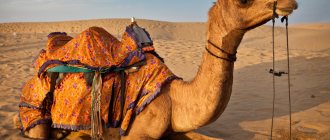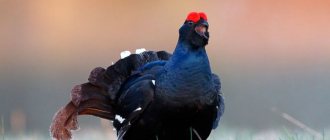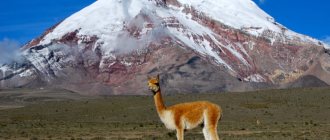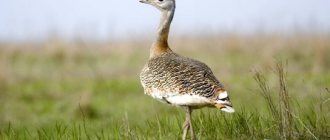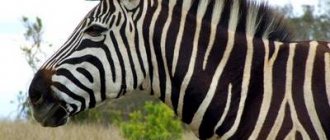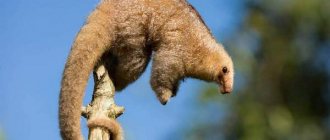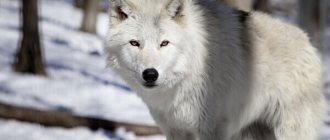Description
— Advertising —
The height of the Bactrian camel exceeds 2 m, together with the humps it reaches 2.7 m. The saddle between the humps is located at a height of about 1.7 m, which makes it difficult to climb onto a standing camel and requires it to kneel or lie down. The distance between the humps is about 30 cm. The weight of an adult male reaches 500 kg or more. Females weigh less, from 320 to 450 kg. A young camel grows up to 7 years.
The Bactrian camel has a dense build, a rounded body, long legs with cloven feet that rest on a callus pad. No hooves. The neck is long, strongly curved, at first it bends down and then rises up in a U-shape. The tail is relatively short, up to 0.5 m in length, with a tassel at the tip. The coat is thick and dense, forming a long dewlap at the bottom of the neck. Long hair also grows on top of the humps, on the head and scruff of the neck. The Bactrian camel is painted brown-sand in different shades. Among domestic camels, brown, gray, black, white, and cream camels are common. The Bactrian camel is characterized by long and thick eyelashes and fleshy lips. The ears are round and small. A healthy camel has smooth humps and stands straight. On the back of the head there are paired glands that secrete a viscous and odorous black secretion for marking territory.
The voice of the Bactrian camel is a bit like the braying of a donkey. A camel loaded with packs roars when it rises from the ground or falls onto it.
Unique body functions
The main places where camels live are deserts and semi-deserts. An animal can exist in such harsh climatic conditions due to the unique functioning of its body.
One of the most important points is the presence of thick wool, thanks to which the camel can withstand fantastic temperatures - from -29 to +38 degrees. Another important fact is the ability to regulate body temperature depending on the environment. At night it drops sharply and slowly rises towards the middle of the day. Thanks to this, the camel does not feel hot, even if the temperature around it is much higher.
Features of camel nutrition
— Advertising —
The Bactrian camel is an exclusively herbivore, feeding even on rough and poorly nutritious food. May eat plants with thorns.
The diet of wild camels consists of shrub and semi-shrub saltworts, onions, barnyard grass, parfolia, ephedra, saxaul, poplar and reed leaves. In the absence of such food, camels feed on animal bones and skins. In general, it tolerates fasting well.
The role of the camel's body's food supply is played by the fat contained in its humps. It does not split into water, but serves for thermal insulation. Two humps contain up to 150 kg of fat.
Camels come to water sources once every few days. They can easily survive without water for 2-3 weeks, especially in the summer, when moisture accumulates in the plants after rains. A camel survives even if it loses 40% of its body water. In addition, the Bactrian camel can drink salt water from desert reservoirs. At the same time, a camel can drink a lot of water at one time. For severe dehydration – more than 100 liters.
What do Bactrian camels eat?
Photo: Bactrian camel from the Red Book
Bactrian is a completely harmless herbivore.
The main diet of Bactrians consists of:
- shrubs and subshrubs of the Sálsola (Salyanka) plant;
- camel-thorn;
- ephedra (Éphedra);
- young shoots and leaves of Saxaul (Halóxylon);
- barnyard grass, parnofolia.
The structure of the camel's mouth and lips is designed in such a way that these animals can pick and eat hard and prickly plants with large needles without harm to the body. In autumn, camels can feast on poplar leaves, reeds, and onions. In winter, when there is no vegetation and camels need a source of protein, camels can eat animal skins and bones. Wild camels can easily drink salt water from reservoirs. Domestic camels can be more picky and require clean water to drink. In winter, domestic camels can eat hay, oats, buckwheat grass, porridge made from it, and breadcrumbs. In summer, camels look for hard grass.
Bactrians are loved to be kept in agriculture because they are indiscriminate in food and unpretentious in the conditions of their detention. Camels, like many warm-blooded animals, recover greatly by autumn. They store fat in their humps to make it easier to survive the winter. Camels easily survive long periods of fasting. For these animals, sometimes fasting is even better than overfeeding.
Camel distribution
Previously, wild camels were found throughout a wide area of Central Asia. They lived in the Gobi, desert regions of Mongolia and China: from the Yellow River to Kazakhstan and Central Asia.
At the moment, there are several isolated areas where wild camels live, which are located in Mongolia and China.
Conservation status of the species
The domestic Bactrian camel is a common animal in Central Asia, Mongolia and China. In Russia, the largest number of camels are kept in Buryatia and Kalmykia. The world population exceeds 2 million animals.
The wild Bactrian camel is a very rare animal, listed in the IUCN Red List, in the CR category - a species in critical danger of extinction. The population of these animals numbers only a few hundred individuals. According to some reports, the wild camel is the eighth most endangered mammal in terms of threat.
Common camel species
The most ancient representatives of the camelid family, according to the research of scientists, lived in North America, from where some of them moved to South America, where they survived as llamas, and the second went along the Bering Isthmus to Asia.
Today there are two types of camels:
- Camelus bactrianus: Bactrian camel or Bactrian;
- Camelus dromedarius: dromedary, dromedary, or arabian.
According to fossil finds, the separation of two-humped and one-humped camels occurred approximately 25 million years ago. At the same time, Bactrian camels appeared first, since the embryo of Bactrian camels initially develops two humps, one of which disappears as it develops.
The relationship between the two-humped and one-humped camels is evident in the fact that when crossed they produce a cross called a nar. Outwardly, the bunk resembles a one-humped camel; it is distinguished by one wide hump, the size of which is equal to two Bactrian humps. Nars are very large and strong animals, they are often bred in Uzbekistan, Turkmenistan, Kyrgyzstan, Afghanistan, Iran and Turkey.
Characteristic features of a camel that help it live in the desert
When mentioning a place where camels live, an image of an animal surrounded by endless dunes of sand arises. This amazing creature received its second name - “ship of the desert” for a reason, since from time immemorial it has lived in hot and waterless territories.
The camel manages to live in this way due to its characteristic features. Firstly, the animal has a thick layer of thick fur, which protects its body from overheating, and its body perfectly regulates temperature. Secondly, thanks to its special metabolism, a camel can survive on a small amount of food and live for more than two weeks without a single sip of water. In addition, nature has endowed the animal with a special body structure, which allows it to live in the desert. This is the distinctive functionality of the legs, as well as the presence of thick eyebrows, eyelashes and special muscles located near the nostrils, which protect the animal from sandstorms.
Camel behavior
Camels live in herds of 5-20 individuals, which consist of a dominant male leader, females and young animals. Adult males often live alone.
Under natural conditions, wild camels move from one area to another, preferring to live in rocky, desert areas, plains and foothills, near springs or reservoirs. They can climb mountains. During the day, camels travel 80-90 km. In winter, they migrate 300-600 km to the south.
Camels are active during daylight hours. They usually sleep at night. In bad weather they hide in bushes and ravines.
Wild camels are aggressive, unlike the calmer domestic species. But at the same time, they are alert and extremely timid; in case of danger, they run away at speeds of up to 65 km/h.
Where does the Bactrian camel live?
Photo: Bactrian camel in Mongolia
In the past, camels settled over fairly large areas. Bactrian camels could be found in Asia, China, and Mongolia. In the modern world, the population of Bactrian camels has decreased greatly, and the habitat of the animals has become small. Now these animals live in four small isolated areas in China and Mongolia. In Mongolia, camels can be found in the Gobi. In China, camels live near Lake Lop Nor.
Domestic Bactrian camels can also be found in Asia, Mongolia, Kalmykia, and Kazakhstan. Several breeds of domestic camels were bred for household use: the Mongolian Bactrian camel, the Kazakh Bactrian, the Kalmyk Bactrian. Animals of these breeds differ in size, coat quality, shape, and the size of their humps.
In the wild, Bactrian camels are constantly on the move. They must constantly migrate in order to find a source of water and food. The harsh conditions of the harsh climate do not allow animals to relax. In herd habitats, animals are tied to bodies of water. During the rainy season, camels live near the pond. However, in the summer, drought sets in, and when the reservoirs become shallow and vegetation becomes scarce, camels go in search of water and food.
In summer, camels can go far into the mountains and rise to a height of up to 3200 m above sea level. In the winter season, animals go south. They can travel 400-700 km. towards the south, where they settle near the foot of the mountains and in the valleys where they will be protected from cold winds. In winter, the main thing for camels is to find food for themselves; unlike horses, camels cannot dig through the snow to look for food underneath. Therefore, autumn migration is necessary for camels to save their lives.
Interesting fact: During migration, an adult camel is able to cover a distance of 90-100 km!
Camel breeding
Female and male camels reach sexual maturity at 3-5 years. The rut begins in the fall. Males are very aggressive during this period. They attack each other, roar loudly, and run. In this state, the male poses a danger to humans and animals.
Once every two years, a female camel gives birth to one baby camel. Pregnancy lasts 13 months. Camel cubs are born in the spring, in March-April, with a body weight of approximately 36 kg and a height of about 90 cm. After a few hours, they can follow their mother. Feeding lasts from 6 months to 1.5 years.
Bactrian camels are very attentive to their offspring. The baby camel lives with its mother until it reaches puberty, after which the males begin to live separately, and the females remain in the maternal herd.
Under natural conditions, camels live from 40 to 50 years.
Camel meat and milk
For African nomads, as well as residents of Asian countries, camels are a source of not only warm skin, but also tasty and healthy meat and milk.
Roasted camel is the national dish of nomads and is cooked for several hours over an open fire, with minimal addition of spices and salt.
Camel meat is used to prepare meat stews, various types of shawarma, salted, dried, dried, and also baked in sand. Every part of the camel is used in cooking, from the tongue and palate to the tail and soles of the feet. In European cuisine, camel meat is a delicacy. Delicious pates are prepared from it, stewed with vegetables, and baked. Roasted camel has a pleasant aroma and a unique, spicy taste. On average, meat is cooked from one to five hours - the cooking time depends on the weight of the piece of meat.
Camel meat does not contain any fat, therefore it is a valuable dietary food product. Meat improves the functioning of the heart muscle, digestive organs, improves vision, skin and hair condition, and has a good effect on the mucous membranes of the body. It is rich in valuable minerals such as iron and phosphorus, and various vitamins.
Camel milk is a traditional and favorite drink in the Emirates and Asian countries. Not only kumys is prepared from it, but also various cheeses, dairy and fermented milk products, as well as ice cream. Not only in their homeland, but also abroad, the milk of these animals is highly valued. So in Switzerland, a particularly expensive and delicious type of chocolate is made from it.
Camel milk differs little in taste and appearance from cow milk. The high sodium content allows you to quench your thirst well even on very hot summer days. In addition to sodium, milk contains a lot of protein and fat, calcium, zinc and iron, rarer elements - cobalt and phosphorus, and vitamins.
Domestication of the camel
The domestication of the Bactrian camel occurred before 1000 BC. e. Thus, a camel, which is led by a man by the bridle, is depicted on the Black Obelisk of the Assyrian king Shalmaneser III (IX century BC). In Europe, the Bactrian camel remained an exotic and little-known animal for a long time.
The domestic Bactrian camel is common in Central Asia. It is the main domestic animal of Mongolia and China (about 2 million individuals), and is also common in Kazakhstan, Kyrgyzstan and Central Asia. In addition to countries with traditional breeding, domestic Bactrian camels are found in New Zealand, the USA, Iran and Pakistan. In the breeding regions of the Bactrian camel, it is of economic importance as a pack and draft animal, and as a source of milk, meat and leather.
Nomads keep camels on free grazing, with a sedentary lifestyle - without a leash in sheds or under sheds. The barn must be dry; the bedding of hay, weeds and reeds is changed regularly. In severe frosts, camels are covered with felt blankets.
The working Bactrian camel is very hardy and resistant to extreme conditions: high and low temperatures, lack of food and water. During the day he is able to walk 30-40 km a day with packs of 250-300 kg. The rider travels more than 100 km per day, at a speed of 10-12 km/h.
It is more difficult to control a camel than a horse, as it can be very stubborn. The animal is also quite whimsical in its maintenance.
The meat of the Bactrian camel is edible; that of young camels is tasty. The taste is similar to game meat, but with a sweetish aftertaste. Camel meat is mainly used as food in countries where camels are traditionally bred. National meat dishes are prepared from it (for example, beshbarmak).
Camel hump fat is also an important food product. It is eaten raw and warm after slaughter, which is considered a delicacy, and the cooled fat is used for melting.
Asian peoples also highly value camel milk. It is fattier than cow milk, tastes sweet, but produces less milk. A well-known drink based on sour camel milk is shubat, an analogue of kumis.
Camel wool is a valuable raw material, as products made from it are very warm. It is used to make clothing for astronauts, polar explorers, and divers.
Thick and rough camel skin is used for various crafts (shoe uppers, whips, belts).
The dung of domestic camels is used as fuel for fireplaces; it does not require long drying and produces a small, even, hot and smokeless flame.
Meaning of hump
Many people often believe that the hump of this animal is a kind of waterskin filled with water, from which camels subsequently receive liquid. But this is not entirely true. They can actually store water in reserve, but most of it is not in the growth on their back.
In fact, the hump is filled with fat, which prevents the body from overheating and accumulates nutrients; it is thanks to this feature that the camel can exist for a long time without water and food. The animal loses up to 35% of its total mass without harm to its health and quickly recovers when it finds food. With prolonged hunger or lack of water, fat decomposes, releasing the energy required for life.
Animals store water not only in the dorsal growth, but also in separate cavities that are located in the stomach. Having reached a watering hole, a camel can drink about 130 liters of water.
The hump plays another important role - it normalizes heat transfer . This is due to the peculiarities of the climate of the regions in which the animals live. In the desert, the temperature difference between day and night can reach 60 °C. Fat saves the camel both from the heat (the air in deserts sometimes warms up to 50°C) and from cold snaps at night, when the temperature drops to -15°C even in summer.
The rays of the sun in the summer are so hot that if you leave an egg in the sand for 30 minutes, it will become hard-boiled, and many mammals can get sunstroke or die from overheating. All camel breeds are free from this risk. The thickness of the fat pad is so large that body temperature is always within normal limits.
A camel is an absolutely unpretentious animal that can survive even in very harsh conditions. It can go without water and food for a long time, and also survive strong sandstorms, reducing activity to almost zero. This message about the camel can be useful not only in preparing for the lesson, but also for the general education of children.
Interesting Facts:
- The Russian name “camel” comes from the Proto-Slavic, in its very borrowed Gothic word “ulbandus”, which translates as “elephant”. Camels were mentioned in the Tale of Bygone Years.
- In Mongolia and China, nature reserves have been created to preserve the population of wild camels.
- The Bactrian camel is depicted on Russian Kara-Kum sweets, although they are rare in the Karakum Desert, where Bactrian camels are bred.
- Multiple Sambo champion Olzhas Kairat-uly (Kazakhstan) lifted a Bactrian camel and carried it 16 meters.
Taxonomy
Russian name - Bactrian camel Latin name - Camelus bactrianus English name - Domestic bactrian camel Order - artiodactyla (Artiodactyla) Suborder - calloused (Tylopoda) Family - camelids (Camelidae) Genus - camels (Camelus)
There are wild and domestic Bactrian camels. The wild camel in Mongolia, its homeland, is called haptagai, in contrast to the domestic one - Bactrian (the word comes from the name of the ancient region in Central Asia, Bactria).
Listen to the voice of a dromedary camel
Camels are very good swimmers, despite their height and weight.
Two males take part in traditional camel fights held in Turkey
A feature of Bactrians is their frost resistance. Thanks to their thick wool, they tolerate low temperatures (down to minus 40 degrees), but heat and drought are very destructive for them. The same cannot be said about dromedaries: they prefer hot sun rather than cold.
Female dromedary camel (Camelus dromedarius) with a rare black camel calf
Differences between domestic camels and wild ones
These animals are able to live without water for a long time, but they really drink a lot once they get to it. They have excellent endurance, which allows them to be used instead of horses in hot climates. Humps are used to accumulate water reserves.
Mating of domesticated camels
Externally, a domesticated camel is almost no different from its wild ancestor. However, some features are present. So, in wild animals:
- smaller hooves;
- the body is less elongated at the sides;
- the muzzle is more elongated and the ears are short;
- less height;
- a smaller hump, which makes animals more vulnerable to drought;
- absence of calluses on the legs and chest.
Wild camels are almost never found in nature due to processes of urbanization and domestication. There are no more than 3,000 of them left in the world.
Unusual camel mating rituals
Maintaining a large herd is troublesome, as camels show aggression during the breeding season. When aroused, males blow bubbles of saliva. They hang down on the sides of the muzzle in large numbers. When they see another male, a fight often breaks out, and sometimes they try to mate with each other.
The rut begins in these animals in the fall. During sexual activity, they roar loudly and rush in different directions. In every herd there are dominant males who are the strongest. They drive females into one or more groups, not allowing them to disperse. If someone tries to violate the boundary of such a male, then he attacks, regardless of whether it is a person or another camel who has invaded his territory.
During a fight, camels try to crush their opponent with their neck, pinning him to the ground. In rare cases, teeth are used. Thus, the timely intervention of a shepherd can save a weaker individual from severe injuries.
Important. In areas where wild camels are found, it is necessary to carefully herd the herd. Attacks on domestic males often occur in order to take away females. An unarmed person cannot repel such an attack.
The occipital gland in camels is used to mark territory. They touch the back of their heads to the ground and stones, arching their necks in an unnatural way. They also spray urine on their hind legs and smear it with their tail, enhancing their scent.
When they see a female, males blow pink bubbles to attract her attention. Usually the female camel chooses the one whose bladders are the largest. In this case, she lies down in front of him, bending all her legs under her. It is worth noting that the male camel tries to impregnate the maximum number of females during the rutting period.


